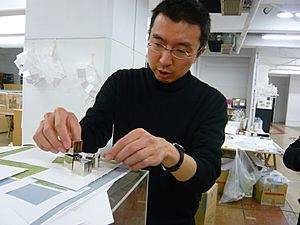Sou Fujimoto facts for kids
Quick facts for kids
Sou Fujimoto
|
|
|---|---|
| 藤本 壮介 | |

(2009)
|
|
| Born | 1971 (age 53–54) Hokkaido, Japan
|
| Nationality | Japanese |
| Alma mater | University of Tokyo École Spéciale d'Architecture |
| Occupation | Architect |
| Organization | Sou Fujimoto Architects |
Sou Fujimoto (born in 1971) is a famous Japanese architect. He is known for designing buildings that look light and airy. His designs often use many small parts to create a bigger space.
Contents
Early Life and Learning
Sou Fujimoto was born in Hokkaido, Japan, in 1971. He studied architecture at the University of Tokyo and finished in 1994. After that, he started his own architecture company called Sou Fujimoto Architects in 2000. In 2021, he also earned a master's degree from a special architecture school in Paris, France.
His Amazing Career
Since starting his company, Fujimoto has designed many buildings. You can find his work all over Japan and in Europe. He believes that how a building is used depends on what people do inside it. This idea guides many of his unique designs.
Designing for the Future
In 2019, Sou Fujimoto was chosen to help "reinvent" Paris, France. He was one of 23 architects picked for this big project. His part included redesigning an area in the 17th part of Paris. He also helped judge the Holcim Foundation Awards in 2025. These awards celebrate buildings that are good for the environment.
Fujimoto is famous for his light and open building designs. He often uses many small pieces to make a bigger structure. In 2013, he was chosen to design the temporary Serpentine Gallery Pavilion in London. This is a special building that is put up for a short time each year.
Books and Ideas
In 2008, Fujimoto wrote a book called Sou Fujimoto: Primitive Future. This book shows many of his projects up to that time. It also explains his special idea of "primitive future" and how he uses it in his work. This idea is about going back to basic shapes and ideas in architecture.
Cool Buildings He Designed
Here are some of the interesting buildings Sou Fujimoto has designed:
- Final Wooden House, Kumamoto, 2005–08
- Children's Centre for Psychiatric Rehabilitation, Hokkaido, Japan, 2006
- T House, Gunma, Japan, 2006–2010
- N House, Oita, 2008
- House before House, Utsunomiya, 2009
- Tokyo Apartment, Tabashi-ku, Tokyo, 2006–10
- Musashino Art University Museum and Library, Tokyo, Japan, 2010
- Toilet in Nature, Chiba, Japan, 2012
- House K, Nishinomiya, Hyogo, Japan, 2011–2013
- Serpentine Gallery Pavilion, London, 2013
- Bus Stop in Krumbach, Austria, 2014
- Naoshima Pavilion, Naoshima, Kagawa, Japan, 2016
- L'Arbre Blanc (The White Tree), Montpellier, France, 2017
- House of Hungarian Music, Budapest, Hungary, 2022
- Mille Arbres (A Thousand Trees), Paris, France, 2016–2023
- Grand Ring, Osaka, Japan. This huge ring structure is part of the Expo 2025 in Osaka.
Awards and Recognition
Sou Fujimoto has won many awards for his amazing designs. Some of them include:
- JIA New Face Award, 2004
- International Design Competition for the Environment Art Forum, 1st Prize, 2004
- Wooden House Competition, Kumamoto, 1st Prize, 2005
- Architectural Review Award Grand Prize, 2006
- Kenneth F. Brown Architecture Design Award, 2007
- Japanese Institute of Architecture Grand Prize, 2008
- Wallpaper Design Award, 2009
- Taiwan Tower International Competition: First Prize, 2011
- Marcus Prize for Architecture, 2013
- Kyoto Global Design Awards Best100, 2023
Images for kids
See also
 In Spanish: Sou Fujimoto para niños
In Spanish: Sou Fujimoto para niños







